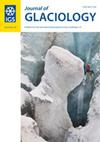Effects of topography on dynamics and mass loss of lake-terminating glaciers in southern Patagonia
IF 2.6
3区 地球科学
Q2 GEOGRAPHY, PHYSICAL
引用次数: 1
Abstract
Calving glaciers are highly sensitive to bedrock geometry near their terminus. To understand the mechanisms controlling rapid calving glaciers’ mass loss, we measured the lake topography in front of four lake-terminating glaciers in the southern Patagonian icefield. Using remotely sensed surface elevation data, we calculated flotation height and surface slope and compared those with changes in ice-front position, surface speed and surface elevation. Rapid retreat accompanied by rapid flow acceleration and ice surface steepening was observed at Glaciar Upsala from 2008–2011, and at O'Higgins and Viedma glaciers from 2016–present. Surface lowering in the lower part of Glaciar Upsala reached 30 m a−1 and was 18 m a−1 and 12 m a−1 at O'Higgins and Viedma glaciers, respectively. Near- or super-buoyant conditions were observed prior to these events, leading to gradual flow acceleration due to low effective pressure and decoupling from the bed. The super-buoyant condition and gradual acceleration imply full-thickness buoyant calving, which causes the ice front to retreat from the shallow bedrock topography with substantial flow acceleration. We conclude that the buoyancy force plays an important role in the rapid mass loss of lake-terminating glaciers in southern Patagonia.地形对巴塔哥尼亚南部湖泊冰川动力学和质量损失的影响
正在崩解的冰川对其终点附近的基岩几何形状高度敏感。为了了解控制冰川快速崩解的机制,我们测量了巴塔哥尼亚南部冰原四个湖泊终止冰川前的湖泊地形。利用遥感地表高程数据,计算浮力高度和地表坡度,对比冰锋位置、地表速度和地表高程的变化。2008年至2011年,乌普萨拉冰川和2016年至今的O'Higgins和Viedma冰川观测到快速退缩,同时观测到快速流动加速和冰面变陡。Upsala冰川下半部分的地表下降幅度为30 ma−1,O’higgins冰川和Viedma冰川的地表下降幅度分别为18 ma−1和12 ma−1。在此之前,观察到近浮力或超浮力条件,由于有效压力低且与床层分离,导致流动逐渐加速。超浮力条件和逐渐加速意味着全层浮力崩解,导致冰锋从浅层基岩地形后退,水流加速明显。我们认为,浮力在南巴塔哥尼亚终湖冰川的快速质量损失中起着重要作用。
本文章由计算机程序翻译,如有差异,请以英文原文为准。
求助全文
约1分钟内获得全文
求助全文
来源期刊

Journal of Glaciology
地学-地球科学综合
CiteScore
5.80
自引率
14.70%
发文量
101
审稿时长
6 months
期刊介绍:
Journal of Glaciology publishes original scientific articles and letters in any aspect of glaciology- the study of ice. Studies of natural, artificial, and extraterrestrial ice and snow, as well as interactions between ice, snow and the atmospheric, oceanic and subglacial environment are all eligible. They may be based on field work, remote sensing, laboratory investigations, theoretical analysis or numerical modelling, or may report on newly developed glaciological instruments. Subjects covered recently in the Journal have included palaeoclimatology and the chemistry of the atmosphere as revealed in ice cores; theoretical and applied physics and chemistry of ice; the dynamics of glaciers and ice sheets, and changes in their extent and mass under climatic forcing; glacier energy balances at all scales; glacial landforms, and glaciers as geomorphic agents; snow science in all its aspects; ice as a host for surface and subglacial ecosystems; sea ice, icebergs and lake ice; and avalanche dynamics and other glacial hazards to human activity. Studies of permafrost and of ice in the Earth’s atmosphere are also within the domain of the Journal, as are interdisciplinary applications to engineering, biological, and social sciences, and studies in the history of glaciology.
 求助内容:
求助内容: 应助结果提醒方式:
应助结果提醒方式:


